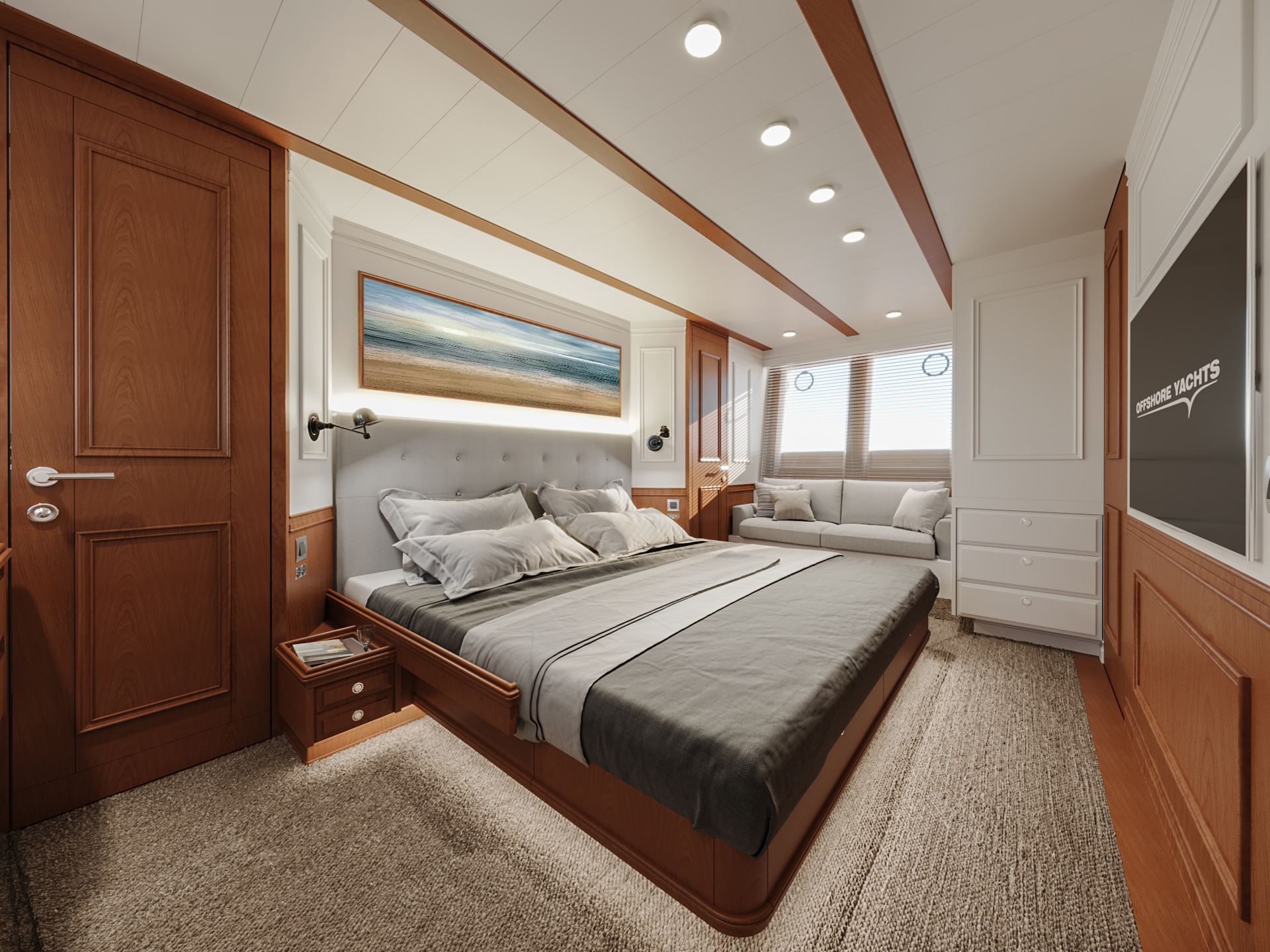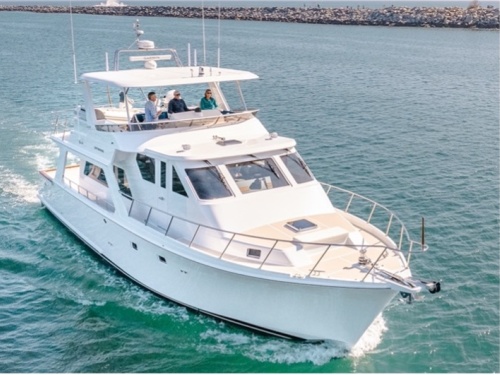Access More Boat Tests
Already have an account? Login
Offshore Yachts CE Series (2022-)
Brief Summary
Offshore Yachts' exciting new CE Series is a line of semi-custom cruising yachts that the company expects will have a broader market reach while maintaining the Offshore Yachts DNA of ride comfort, safety and reliability. The series consists of two models, the Explorer and Cruising in 65’ (19.81 m), 68’ (20.73 m) and 72’ (21.95 m) lengths, the latter being an Aft Cockpit version of the 65’.
Captain's Report

Report by Eric Colby
Mission Critical Objectives
Offshore Yachts’ design brief for the 65’ (19.81 m), 68’ (20.73 m) and 72’ (21.95 m) boats in the CE Series says the mission is “not a revolution but a modern evolution.” They are built on a semi-custom basis as coastal cruisers and the three length choices are available in Explorer and Cruising models with a choice of Contemporary or Classic interior designs.

Each CE model meets the design objectives of shallow draft for access to rare anchorages. Easy access to the water by virtue of a large molded “teak beach” or an optional high/low platform for activities like snorkeling and diving, or dining at water’s edge. Seamless indoor outdoor living on the main deck with a very open feel, while below decks her large windows provide lots of light and views from every cabin.
A Rich History
Offshore Yachts can trace its origins to World War II when steel shortages led the United States Navy to consider alternative hull materials. Richard O. Hunt, who would found Offshore Yachts, used fiberglass to build auxiliary naval boats. After the war in 1948, Hunt built some of the earliest fiberglass pleasure cruisers. A decade later, his sons joined him at the business. In the 1960s, Offshore Yachts sought out naval architect William Crealock and his deep forefoot designs led to Offshore’s successful high-speed Marauder series that was built in the 1960s and ’70s. In 1983, Crealock extended the deep-forefoot design to the first Offshore 48. More recent designs have been drawn by Doug Sharp.

New Bottom Design
For the bottom, Offshore turned to Barracuda Yacht Design, which was founded by Inigo Toledo in 1989. He was trained at the Southampton Institute of Higher Education and has worked with two America’s Cup campaigns and designed sail and power vessels ranging from 25’ (7.62 m) to 115’ (35.05 m). The firm also worked in the design team of Fortuna, “Spain’s Royal Motoryacht, a 142’ (43.28 m) performance yacht powered by 21,000-hp turbines that runs 70 knots at top speed.
The design of the CE Series features a more vertical bow with deeper V sections that are intended to deliver a softer ride.
They also create a longer waterline and provide a thinner angle of entry, producing a steadier ride with less tendency to pitch in waves. Barracuda says the longer waterline and plumb bow also provide better efficiency and lower fuel consumption at all speeds. If a boat has a 100,000-lb. (45,359.24 kg) displacement and a waterline of 65’ (19.81 m) instead of 60’ (18.29 m), the cross section of the yacht is about 8% less, which reduces drag.
The bottom uses a hard double-chine concept at the bow that has been proven on previous Offshore Yachts models. Barracuda says the design enhances stability but doesn’t cause hull slap while at rest because it doesn’t cross the waterline except for the lower chine at the bow. Aft sections are flatter to improve efficiency at higher speeds. Prop tunnels are kept soft and there is a short keel that has been implemented to provide control in following seas. This follows previous positive experience in this field with various models.


Offshore Yachts CE Series Major Features
- Two models, Explorer and Cruising
- Three Full-Beam Cabin Layout. Option for four cabins
- Crew Quarters aft, accessible and independent of guests
- Galley Integrates with Salon and Aft Deck
- Large molded Swim Platform or hydraulic lift
- Large Flying Bridge


Offshore Yachts CE Series Features Inspection
The Explorer layout has a single-level fixed swim platform that’s 6’9” (2.05 m) deep and can be arranged with removable chairs and a table. On the Cruising version, the platform is two levels and it’s intended to hold the tender.


The aft deck on both layouts has gate to the swim platform with a lounge across the stern plus a large table. There are hullside doors that open outward on each side and there’s open space to keep the area from feeling crowded. On each version, the bow has a lounge area with forward facing seating. The side decks are partially protected from the flying bridge overhang and forward, there are dedicated fender racks. For ground tackle, the windlass is recessed below deck level to reduce the tripping hazard. The anchor passes through the stem. There is also an option for a double anchor system.


Light-looking proper stairs, not a ladder, with an open tread design lead up to the flying bridge and maintain the aft view.
On the Explorer version, the aft half of the flying bridge is reserved for a standard tender measuring 14’2” (4.3 m) long, with options for 15’ to 16’ (4.58 m to 4.88 m) tenders with modified railing. A bar with a grill is aft to port with an L-shaped lounge just ahead. The upper helm has two captain’s chairs and both versions have indoor stairs that lead down to the salon.
On the Cruising version, there’s a lounge that wraps around a table in the aft starboard corner with another lounge and table forward. To port, there’s another lounge just abaft the upper helm that has two captain’s chairs. A sunpad forward of the helm covers nearly the full width of the flying bridge.



Sectional Sliding Glass Doors seamlessly link the aft deck and the salon on all layouts. Tall superstructure windows work with the large sliding door to create outstanding views. The owner can choose the Classic or more modern Contemporary style. The connection between interior and exterior adds to the experience of enjoying being at sea.
The Cruising edition has the galley aft with a table opposite. This design makes it easy to serve guests on the aft deck as well. Forward is a large U-shaped lounge wrapping around a table with a smaller sofa to starboard. Stairs to starboard lead down to the accommodations deck and up to the flying bridge. Forward and opposite, to port there is another L-shaped lounge with a small table. The lower helm puts the captain on the centerline with a companion alongside to starboard.
On the Explorer, the larger lounge and sofa are aft with the galley and additional cold storage just ahead. The starboard stairs and port lounge on the helm deck are the same as with the Cruising and the helm has the captain’s chairs separated instead of side-by-side, but almost any combination is possible upon request. Also, on both layouts, there is a door to starboard of the helm that leads to the side deck.




Offshore Yachts CE Series Accommodations



On the Cruising and Explorer versions, there are two sets of stairs leading to the accommodations deck. The central one leads to the master and VIP while the forward steps take guests to the bridge, which takes us to the forward cabin.
All three cabins use the full beam, which a design element not often seen in class.
The master stateroom is amidships with the berth on the centerline. A TV is on the forward bulkhead and there are hanging lockers in the corner on each side. Outboard to port is a lounge with a vanity and ottoman to starboard. Doors on each side of the berth lead aft to his and hers head compartments with their own separate shower.
The central cabin can be a single VIP or made into two separate cabins, in both versions, Cruising and Explorer. There are various options for two twin cabins or for a twin plus a double cabin, at the Owner’s choice. Again, all combinations are possible.
In the VIP, just ahead, of the master, the head is aft with a separate shower stall and the berth is forward with a lounge outboard to port and a smaller vanity to starboard.
When two smaller cabins replace the VIP, there will be an optional fourth cabin with over-under bunks to port and a stateroom to starboard with nearly queen-sized dimensions. These two cabins share a head that is aft to port.
The forward cabin can be converted between a double or a twin cabin, moving berths and night stands. It has the berth slightly offset to port with a TV on the forward bulkhead. In something of a departure from conformity, the head is forward in the bow, allowing the berth to be aft, at a less motion point of the boat.






Offshore Yachts Construction
Offshore Yachts says its craftsmen put hundreds of hours of long-board sanding to get the mold quality the company demands — optically straight gelcoated surfaces. Window openings are laminated into the cabin sides, which Offshore says eliminates the possibility of leaking windows. This follows the most recent techniques in bonding windows in cars or trains. Exterior fiberglass surfaces including hatch and window frames are finished with higher-gloss gelcoat. A look inside every compartment or locker will reveal smooth, finished surfaces.
All laminates are hand applied and include Knytex bi- and tri-directional weaves and vinylester resins below the waterline. This provides greater strength and lighter weight compared to conventional woven roving. Above the waterline, closed-cell foam is vacuum bagged with the bi- and tri-directional fabric using isopthalic and vinylester resins. Less weight for equivalent strength ultimately benefits fuel consumption and range.

The hull is a single laminated piece and inside are four full-length stringers, multiple athwartships frames and full bulkheads. This is followed the by main deck and cabin, which are bonded to the hull. Finally, the deck, flying bridge and pilothouse roof are one fiberglass piece that is fiberglassed to the cabin structure. Heavier laminates are used at the bow to create a crash bulkhead. The hull-to-deck joint is heavily laminated to become a structural component of the hull. They are capped with solid stainless steel to provide protection when coming alongside a dock or piling.

The bilge area is separated into five sections to increase watertight integrity. Each section has its own automatic bilge pump and can be made common by gate valves in each section. Main bulkheads consist of multiple layers of PVC Foam-cored fiberglass and each is insulated to reduce vibration and deaden sound, same as for sole panels and ceilings, all elastically mounted.
Observations
With the CE Series, Offshore Yachts plans to expand its reach to a larger audience. By offering models, the Explorer and Cruising in 65’ (19.81 m), 68’ (20.73 m) and 72’ (21.95 m) lengths, the CE Series should appeal to owner/operators who have been fans of its yachts, but didn’t want to get into larger vessels. The company calls the series “a modern evolution.” They are built in Taiwan at an experienced yard on a semi-custom basis as coastal cruisers and a client can choose from a more-modern Contemporary style or Classic interior designs.

